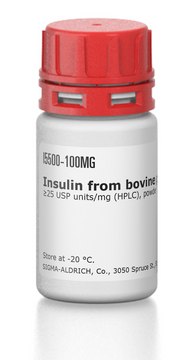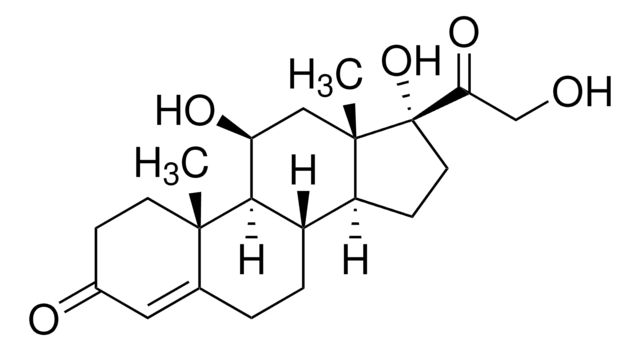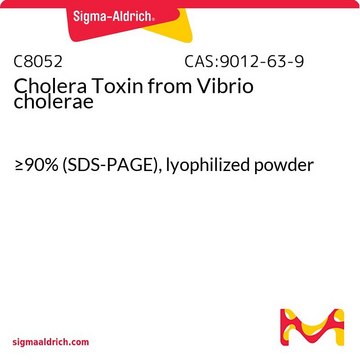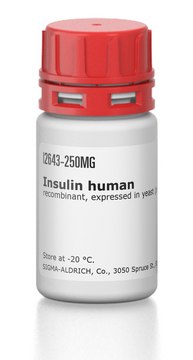I1882
Insulin from bovine pancreas
γ-irradiated, BioXtra, suitable for cell culture, potency: ≥20 units/mg (USP units), lyophilized powder
Synonym(s):
Bovine insulin, Cell culture grade insulin
About This Item
Recommended Products
Quality Level
sterility
γ-irradiated
product line
BioXtra
form
lyophilized powder
potency
≥20 units/mg (USP units)
technique(s)
cell culture | mammalian: suitable
solubility
acetic acid: 2 mg/mL (pH: 2-3)
hydrochloric acid: 2 mg/mL (pH: 2-3)
UniProt accession no.
shipped in
ambient
storage temp.
−20°C
InChI key
IXIBAKNTJSCKJM-BUBXBXGNSA-N
Gene Information
bovine ... INS(280829)
Looking for similar products? Visit Product Comparison Guide
Application
Biochem/physiol Actions
Other Notes
Physical form
Reconstitution
related product
Storage Class Code
11 - Combustible Solids
WGK
WGK 3
Flash Point(F)
Not applicable
Flash Point(C)
Not applicable
Personal Protective Equipment
Regulatory Information
Choose from one of the most recent versions:
Already Own This Product?
Find documentation for the products that you have recently purchased in the Document Library.
Which document(s) contains shelf-life or expiration date information for a given product?
If available for a given product, the recommended re-test date or the expiration date can be found on the Certificate of Analysis.
What is the comparison between International Units (IU) and USP units for insulin?
The international unit (IU) of insulin is based on the International Standard Preparation of Bioassay (1958). The standard preparation is a mixture of 52% bovine and 48% porcine insulin, containing 24 units/mg. Reference: Martindale: The Extra Pharmacopoeia, 29th ed., p. 392. High purity bovine pancreatic insulin typically assays at approximately 27 USP units per mg. So the IU and USP unit are not identical, but they are approximately 1:1.
What can be used to make a solution of insulin?
Insulin is soluble in dilute acids and alkalis. The solubility of insulin is tested at 2 mg/mL in water (acidified to pH 2 with hydrochloric acid). One can also use 1 mL of water acidified to pH 2 with 10 μL of glacial acetic acid to dissolve 2 mg of insulin. A 10 mg/mL solution of bovine insulin in 25 mM HEPES at pH 8.2 is offered as Product No. I0516.
How can I store the insulin solution? How long?
The USP recommends that solutions of insulin be stored at 2-8°C. It is not recommended to freeze solutions of insulin, as it can aggregate. Sterile solutions should be stable for at least 1 year at 2-8°C.
What is the amino acid sequence for Product I1882, Insulin from bovine pancreas?
The sequence and structure of insulin can be found on the product information sheet (under Documents, above).
How many units of insulin are present in one vial of Product I1882, Insulin from bovine pancreas?
Product No. I1882 has a potency specification of not less than 2520 USP units per vial. For a vial that contains (nominally) 100 mg, that works out to 25.2 USP units/mg. The potency in terms of units per vial can be found the on lot-specific Certificate of Analysis.
How do I get lot-specific information or a Certificate of Analysis?
The lot specific COA document can be found by entering the lot number above under the "Documents" section.
How do I find price and availability?
There are several ways to find pricing and availability for our products. Once you log onto our website, you will find the price and availability displayed on the product detail page. You can contact any of our Customer Sales and Service offices to receive a quote. USA customers: 1-800-325-3010 or view local office numbers.
What is the Department of Transportation shipping information for this product?
Transportation information can be found in Section 14 of the product's (M)SDS.To access the shipping information for this material, use the link on the product detail page for the product.
My question is not addressed here, how can I contact Technical Service for assistance?
Ask a Scientist here.
Our team of scientists has experience in all areas of research including Life Science, Material Science, Chemical Synthesis, Chromatography, Analytical and many others.
Contact Technical Service







